Tackling High-Density Designs
As electronic devices shrink in size, the density of components on PCBs increases dramatically. Modern smartphones and other compact devices require a very high component density, with connections often measuring less than 0.4 millimeters apart. This miniaturization introduces significant challenges for PCB routing. Designers must ensure that signal integrity is maintained despite the proximity of traces, which can lead to issues like crosstalk and electromagnetic interference. For instance, reducing trace spacing below 0.2 millimeters can significantly increase the risk of electrical shorts and signal interference.
Managing Signal Integrity
Signal integrity is a major concern in high-speed PCB designs. For high-speed transmission, such as in USB 3.0 or HDMI interfaces, maintaining a controlled impedance is crucial. Typically, a trace width of around 0.1 mm is required for a 90 ohm differential pair impedance in a USB 3.0 circuit. This precise control over trace dimensions is necessary to prevent issues such as signal reflections and timing delays, which can degrade the performance of the entire system.
Heat Dissipation Challenges
Heat management is critical in PCB design, especially as component packing increases. Components such as CPUs and power transistors generate significant amounts of heat, which if not properly dissipated, can reduce the overall reliability and lifespan of the device. Effective PCB routing must therefore include strategies for heat management, such as optimizing the placement of heat-generating components and using thermal vias. These vias can help reduce the temperature by as much as 10 degrees Celsius in high-power applications.
Adherence to Manufacturing Limitations
Each PCB manufacturer has specific capabilities and limitations, which can include minimum trace widths, minimum spacing, and via sizes. For instance, a standard PCB manufacturer might be able to reliably produce traces and spaces as small as 0.1 mm, but more advanced techniques might be required to go smaller, often at a higher cost. Designers must navigate these limitations while trying to meet the design requirements of increasingly complex electronic devices.
Cost-Effective Material Utilization
The choice of materials and the efficiency of the routing directly impact production costs. Materials with better electrical properties, such as low dielectric constants and high thermal conductivity, can be more expensive. Efficient routing that minimizes the use of expensive materials while maintaining performance is a critical skill for PCB designers. For example, using high-frequency laminate materials might be essential for certain applications but can increase the cost of the PCB by 20% to 30%.
Understanding these challenges is crucial for anyone involved in PCB design. By mastering efficient and effective pcb routing techniques, designers can overcome these hurdles, leading to better performing, more reliable, and cost-effective electronic products.

